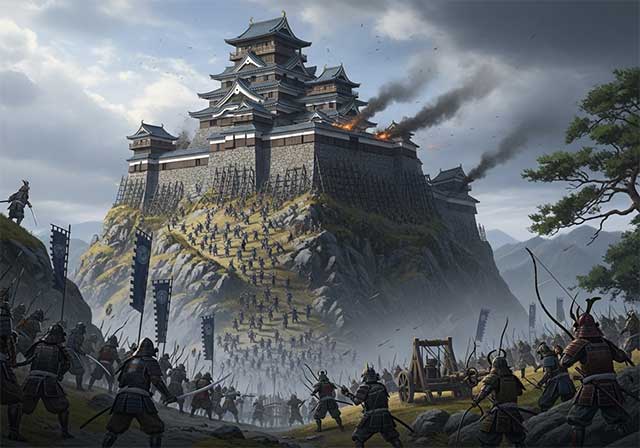
Tihaya Castle was built by Kusunoki Masashige on top of Mount Kongo, separated from the neighboring hills by a deep ravine. The terrain itself provided natural protection, making the position extremely convenient for defense.
According to the Taiheiki, the fortress was located at an altitude of about 220 meters, its perimeter was approximately four kilometers, and its fortifications included walls and watchtowers. The garrison numbered about a thousand soldiers. At the same time, the chronicle claims that the shogunate's troops numbered a million men, although it is obvious that this figure, as in the case of the siege of Akasaki, was greatly exaggerated.
The first assaults
With their huge numerical advantage, the shogunate's warriors did not even bother to erect defensive structures, but immediately rushed into the attack. According to tradition, every samurai strove to be ahead of the others. During the assault, they protected themselves from arrows with heavy wooden shields.
The defenders met the attackers with a hail of stones and logs, which had been prepared in advance in large quantities. The stones broke the shields, after which Masashige's archers struck the defenseless enemies. The losses among the attackers were so great that, according to the Taiheiki, when the commander Nagasaki Shiro Zaemon ordered the dead and wounded to be counted, twelve scribes worked for three days and nights without putting down their brushes, writing down the names of the dead.
After that, a strict order was issued: to attack the castle only on command. The shogunate's army moved on to setting up camp and defensive fortifications.
Cutting off the water supply and Masashige's response
Even before the siege began, the quiet fort of Akasaka fell. This happened because the enemy discovered a hidden underground aqueduct and cut off the water supply, forcing the garrison to surrender.
They decided to use a similar tactic here: since the fortress stood on a separate mountain peak, there were no aqueducts, and the besiegers organized ambushes in places where the defenders could descend into the valley for water. They piled branches on the paths to make the way difficult.
But Masashige had anticipated this as well. Sources of water had been scouted out in advance in the castle—several springs—and about three hundred wooden vats filled with water had been prepared. In addition, a system for collecting rainwater from the roofs of buildings had been set up.
Since none of the defenders went down into the valley, the enemy sentries gradually lost their caution. Masashige took advantage of this: at night, he led about two hundred warriors who attacked one of the ambushes at dawn. Some of the enemies were shot with bows, others were killed with swords. Taking their banners, Masashige's samurai returned to the fortress.
The banners were hung on the walls, which enraged the shogunate's troops. Hotheads immediately launched a new assault, but they were again met with arrows, stones, and whole trees thrown from above. The losses were again horrific.
The blockade and the defenders' tricks
After that, the commander of the siege ordered a long blockade and to starve the fortress into submission. Idle life settled in the enemy camp: tea ceremonies, poetry competitions, and gambling were organized, and prostitutes were invited from neighboring cities.
The defenders decided to take advantage of this. They made dozens of human-sized straw dummies, dressed them in armor, and placed them near the walls at night. At dawn, the garrison raised a battle cry. The besiegers, deciding that Masashige's samurai were preparing a desperate sortie, rushed to the walls, where they were again met with stones and logs.
The burned bridge
Despite the blockade, the fortress held out for a long time. Soon, a messenger arrived from the shogunate headquarters with orders to resume active operations. At a military council, it was decided to build a huge wooden bridge across the narrowest part of the gorge. For this purpose, about five hundred carpenters were brought from Kyoto.
When the bridge was erected, the attackers rushed across it towards the castle. However, Masashige was aware of the enemy's plans in advance. As soon as the first ranks of samurai were on the bridge, the defenders threw burning torches at them and began pouring oil from bamboo tubes. The wood quickly caught fire.
The attackers were trapped: fire raged in front of them, and their comrades pressed in from behind. Soon, one side of the bridge burned through, and the entire structure collapsed into the abyss. Most of the warriors died, crashing into the rocks.
False betrayal
One of the most notable episodes of the siege is connected with the enemy's attempt to persuade one of Masashige's associates to betray him. The shogunate commanders sent him a letter offering to betray the emperor. But the addressee remained loyal to his lord and passed the message on to Masashige.
Masashige decided to take advantage of the situation. According to the agreement, the “traitor” was supposed to surrender one of the towers. A deep moat was dug and carefully camouflaged in front of it. At night, the enemy's vanguard was allowed in, but they fell into the trap and came under fire from archers.
In a hurry, the besiegers began to retreat, and those remaining under the walls decided that the garrison had broken out, and in the confusion, they attacked their own.
End of the siege
Meanwhile, a guerrilla movement led by Emperor Go-Daigo's son was spreading throughout the country. The shogunate's troops, busy with the siege, began to experience food shortages.
The situation worsened when news arrived that Ashikaga Takauji had defected to the emperor with a large army and that Kyoto had fallen. After that, the besiegers hastily lifted the siege of Tihaya Castle and retreated.
See also
-
The Siege of Hara Castle

The Shimabara Rebellion of 1637–1638, which culminated in the siege of Hara Castle, was the last major uprising of the Edo period and had serious political consequences.
-
Battle of Tennoji

The confrontation between Tokugawa Ieyasu and Toyotomi Hideyori during the “Osaka Winter Campaign” ended with the signing of a peace treaty. On January 22, 1615, the day after the treaty was signed, Ieyasu pretended to disband his army. In reality, this meant that the Shimazu forces withdrew to the nearest port. On the same day, almost the entire Tokugawa army began filling in the outer moat.
-
Siege of Shuri Castle

The Ryukyu Kingdom was established in 1429 on Okinawa, the largest island of the Ryukyu (Nansei) archipelago, as a result of the military unification of three rival kingdoms. In the following years, the state's control spread to all the islands of the archipelago.
-
The Siege of Fushimi Castle
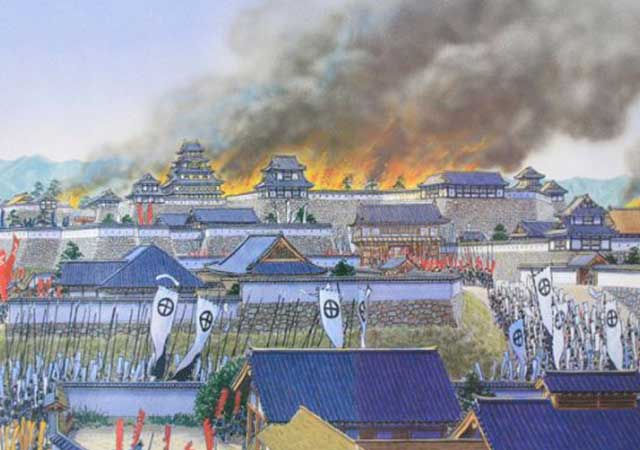
Fushimi can perhaps be considered one of the most “unfortunate” castles of the Sengoku Jidai period. The original castle was built by Toyotomi Hideyoshi in the southeast of Kyoto in 1594 as his residence in the imperial city.
-
The Siege of Otsu Castle
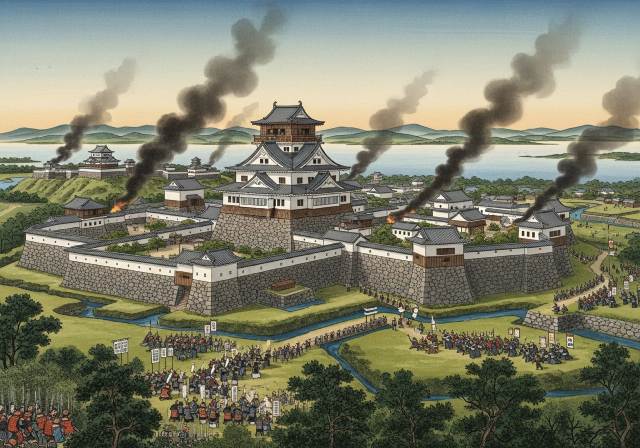
The siege of Otsu Castle was part of the Sekigahara campaign, during which the so-called Eastern Coalition, led by Tokugawa Ieyasu, fought against the Western Coalition, led by Ishida Mitsunari. Otsu Castle was built in 1586 by order of Toyotomi Hideyoshi near the capital Kyoto, on the site of the dismantled Sakamoto Castle. It belonged to the type of “water castles” — mizujō — as one side of it faced Japan's largest lake, Lake Biwa, and it was surrounded by a system of moats filled with lake water, which made the fortress resemble an island.
-
The Siege of Shiroishi Castle
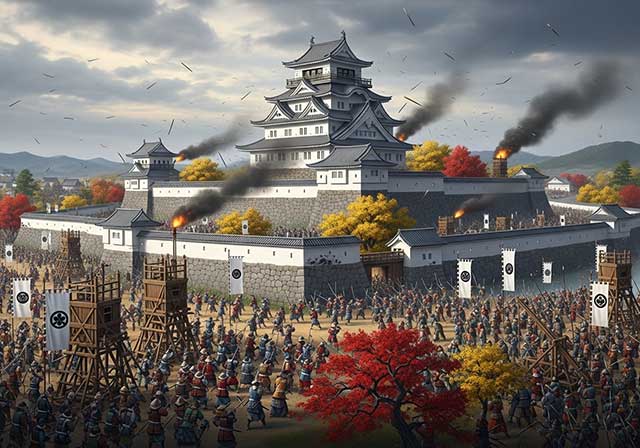
The siege of Shiroishi Castle was part of the Sekigahara campaign and took place several months before the decisive battle of Sekigahara. The daimyo of Aizu Province, Uesugi Kagekatsu, posed a serious threat to Tokugawa Ieyasu's plans to defeat the Western Coalition, and Ieyasu decided to curb his actions with the help of his northern vassals. To this end, he ordered Date Masamune to invade the province of Aizu and capture Shiroishi Castle.
-
The Second Siege of Jinju Castle
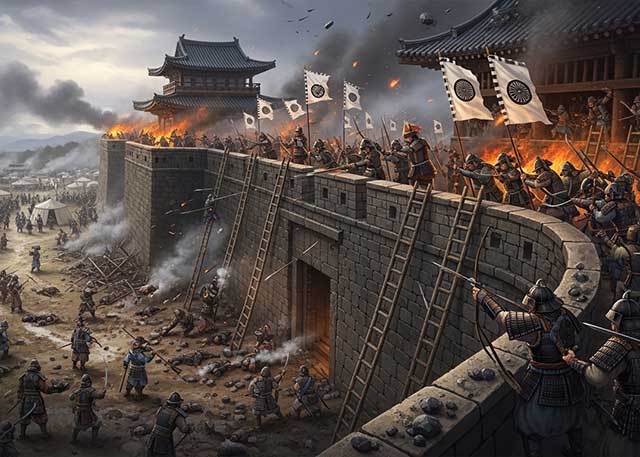
During the two Korean campaigns of the 16th century, the Japanese repeatedly had to capture enemy fortresses and defend occupied or constructed fortifications from the combined Korean and Chinese forces. Among all the operations of that time, the second siege of Jinju Castle is considered the most interesting from the point of view of siege warfare.
-
The Siege of Takamatsu Castle
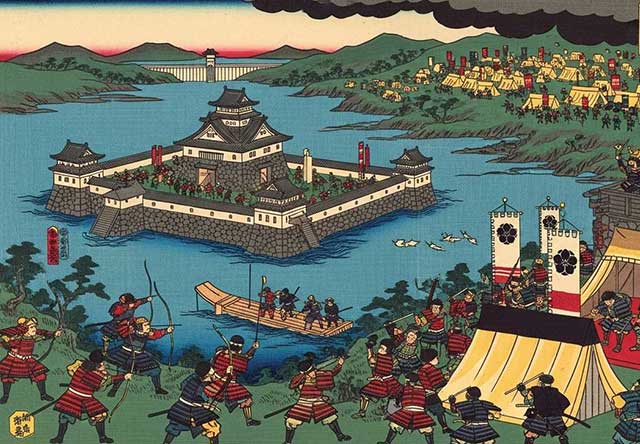
The siege of Takamatsu Castle in Bitchu Province is considered the first mizuzeme, or “water siege,” in Japanese history. Until then, such an original tactic had never been used.

